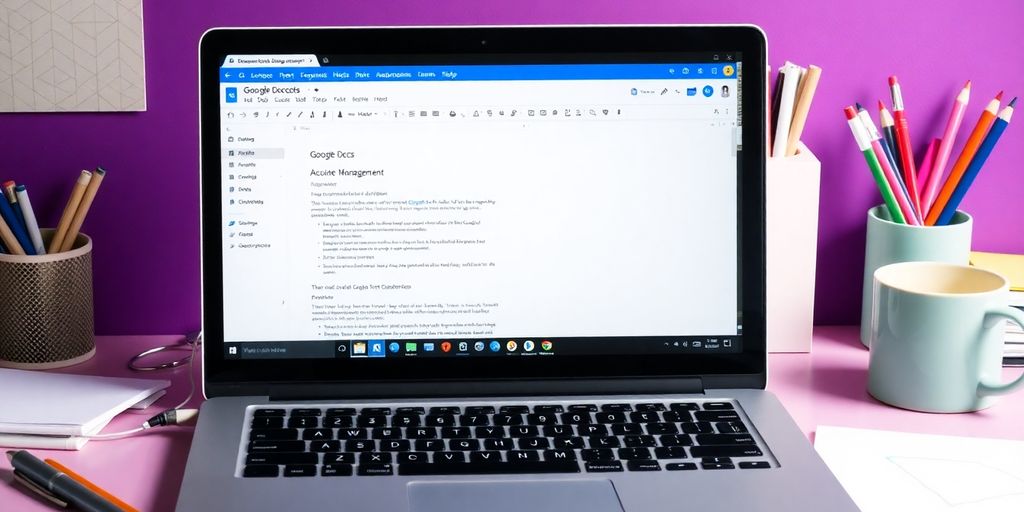Ever feel like you’re juggling too many tools at once? If you’re using HubSpot and Google Docs separately, you might be missing out on some serious productivity boosts. Integrating these two can transform how you manage documents. Imagine having all your files synced automatically and accessible from one place. No more switching between tabs or losing track of the latest version. Let’s dive into the benefits of bringing HubSpot and Google Docs together for a smoother workflow.
Key Takeaways
- Integrating HubSpot with Google Docs keeps all your files in sync, so you’re always working with the latest version.
- You can automate document creation and updates, saving time and reducing manual work.
- The integration supports real-time collaboration, making it easier for teams to work together on documents.
- Access and permissions can be managed effectively, ensuring the right people have the right access.
- Boost your productivity by linking HubSpot with other tools, streamlining your document management process.
Understanding HubSpot Google Docs Integration

What is HubSpot Google Docs Integration?
HubSpot Google Docs Integration is all about connecting two powerful tools—HubSpot, a leading CRM platform, and Google Docs, an essential document creation tool. By linking these platforms, users can streamline their workflow, making it easier to manage documents directly within HubSpot. This integration ensures that your team can access and edit documents without leaving the HubSpot environment. It’s like having your entire document library at your fingertips while working on your CRM tasks.
Key Benefits of Integrating HubSpot with Google Docs
- Centralized Document Management: No more switching between platforms. Access your Google Docs files directly from HubSpot.
- Real-time Collaboration: Teams can work on documents simultaneously, with all updates reflected instantly across both platforms.
- Improved Workflow Efficiency: Automate document-related tasks, reducing manual data entry and saving time.
Integrating Google Docs with HubSpot not only enhances productivity but also promotes a more cohesive work environment by keeping everything in one place.
How to Set Up the Integration
- Connect Your Accounts: Start by linking your Google account with HubSpot. This step is crucial for syncing documents.
- Configure Settings: Adjust integration settings to fit your needs, such as choosing which documents to sync or setting up automation rules.
- Test the Integration: Ensure everything works smoothly by testing document access and syncing. Make adjustments as needed.
For a smooth process, connect your personal Google inbox with HubSpot to access the upload option and ensure seamless document management.
Streamlining Document Management with HubSpot and Google Docs
Syncing Files Between HubSpot and Google Docs
Keeping your files in sync between Google Drive and HubSpot is like having a well-oiled machine. Everything stays updated across both platforms. This means when you tweak a document in Google Docs, it’s reflected in HubSpot automatically. No more manual updates or worrying about out-of-date files. It’s all about having the latest version at your fingertips.
- Link Google Drive documents to specific HubSpot records.
- Automate document creation based on actions in HubSpot.
- Use Google Drive for centralized storage of HubSpot reports.
Automating Document Creation and Updates
Automation is a game-changer. Imagine setting up a system where new documents are created in Google Docs whenever a specific event happens in HubSpot. It’s not just about saving time; it’s about reducing errors. Plus, when a document gets updated in Google Drive, that change can be instantly reflected in HubSpot. This streamlined document workflow enhances efficiency.
- Set up triggers for automatic document creation.
- Ensure updates in Google Drive are mirrored in HubSpot.
- Reduce manual entry and potential errors.
Managing Access and Permissions
Managing who can see and edit your documents is crucial. While Google Drive handles permissions, linking these documents to HubSpot ensures that only those with the right access can view or edit them. This integration means you don’t have to jump between platforms to manage permissions. It’s all about keeping your data secure and accessible to the right people.
With the HubSpot and Google Docs integration, document management becomes less about the hassle and more about the flow. It’s about letting technology handle the heavy lifting so your team can focus on what truly matters.
Enhancing Team Collaboration Through Integration
Collaborative Editing in Real-Time
Real-time editing is a game-changer for teams. Imagine everyone on your team working on the same document simultaneously without stepping on each other’s toes. That’s what Collaborative AI does for teamwork. It’s like having a digital whiteboard where everyone can jot down ideas, make changes, and see updates instantly. This means no more endless email threads or waiting for someone to finish their part. Everyone stays in the loop, making the process smoother and faster.
Sharing Documents Across Teams
Sharing documents across teams has never been easier. With HubSpot and Google Docs integration, you can share files with just a few clicks. Whether it’s a marketing plan or a sales report, everyone who needs access can get it without jumping through hoops. This simple sharing capability keeps everyone informed and aligned. Plus, you can set permissions to ensure that only the right people can view or edit the documents.
Tracking Changes and Version History
Keeping track of changes and maintaining version history is crucial when multiple people are involved in editing a document. With this integration, every edit is logged, and you can easily revert to previous versions if needed. This feature not only saves time but also helps in maintaining the integrity of the document. No more wondering who made what change or when. It’s all there for you to see, making document management a breeze.
"Integration between HubSpot and Google Docs facilitates seamless collaboration by ensuring that everyone is on the same page, literally and figuratively."
Boosting Productivity with Automated Workflows
Setting Up Triggers and Actions
Getting started with automation in HubSpot and Google Docs is like setting up a series of dominoes. You create triggers (like a new document being added) and actions (like sending a notification or archiving a file). This setup means less manual work for you. Imagine not having to remember every little task—automation handles it. Here’s a simple way to look at it:
- Trigger: New document created in Google Docs.
- Action: Automatically log the document in HubSpot.
- Result: Saves time and keeps everything organized.
Automating Routine Tasks
Routine tasks are the silent productivity killers. They sneak into your day and steal time without you noticing. Automating these tasks can give you back hours each week. Think about the things you do over and over—sending emails, updating spreadsheets, or even setting reminders. With HubSpot’s automation tools, you can set these on autopilot and focus on more important work.
Integrating with Other Tools for Enhanced Efficiency
HubSpot and Google Docs aren’t the only players in the game. You can integrate them with other tools you use daily, like Trello or Asana, to create a seamless workflow. This integration makes sure that all your apps talk to each other, reducing the need to jump between platforms. For example, when a document is updated in Google Docs, a task can be automatically created in Trello, keeping your project management on point.
Automation is like having a personal assistant that never sleeps, always ready to tackle repetitive tasks so you can focus on what really matters.
Optimizing Content Marketing Strategies
Centralizing Content Assets
Bringing all your content under one roof can transform how your team works. Imagine not having to scramble through multiple platforms to locate that one elusive document. Centralizing content assets makes this possible by storing everything in one accessible location. This strategy not only saves time but also helps maintain consistency in your messaging.
- Store all documents in a single platform.
- Ensure easy access for all team members.
- Maintain consistent branding and messaging.
Improving Content Accessibility
When your content is easy to find, it’s easier to use. By improving accessibility, you allow your team to quickly locate and utilize the right materials. This means fewer bottlenecks and more efficient workflows.
- Create a clear, intuitive folder structure.
- Use tags and keywords for easy searching.
- Regularly update and archive outdated content.
Leveraging Data for Better Insights
Data is gold in content marketing. By analyzing how your content performs, you can tweak your strategies for better results. Get insights into what works and what doesn’t, and adjust your approach accordingly.
- Track engagement metrics such as views, shares, and comments.
- Use analytics tools to understand audience behavior.
- Refine your content strategy based on data insights.
Efficient content management isn’t just about organization—it’s about making sure your team can access and use the right materials when they need them. By focusing on centralization, accessibility, and data insights, you’re setting the stage for a more productive and effective content marketing strategy.
To align your content organization for 2025, focus on context over hierarchy. This involves reorganizing your content library to fit modern frameworks, ensuring your team can find and use materials effectively.
Ensuring Data Security and Compliance

Managing Data Backups
Keeping your data safe is a big deal, especially when you’re dealing with important documents. Regular data backups are your safety net, ensuring you won’t lose vital information if something goes wrong. To make this work, set up automated backups. This way, your data is regularly saved without you having to think about it. Also, consider using a cloud-based storage solution. It adds an extra layer of protection, as your data is stored off-site, reducing the risk of physical damage or loss.
Setting Up Access Controls
Access controls are like the bouncers of your data world. They decide who gets in and who doesn’t. Start by setting up user roles and permissions. This means only the right people can view or edit sensitive documents. It’s also smart to use two-factor authentication. This adds an extra step for users to verify their identity, making it harder for unauthorized people to get access.
Ensuring Compliance with Data Regulations
Staying on the right side of data regulations isn’t just about avoiding fines; it’s about building trust with your clients. If you’re handling sensitive info, like healthcare data, make sure you’re following all the rules, such as HIPAA. Regular audits can help you spot any compliance gaps. Plus, training your team on data protection practices ensures everyone is on the same page. Remember, compliance isn’t a one-time thing; it’s an ongoing process.
Improving Project Management with Integrated Tools
Organizing Project Files Efficiently
Managing project files can be a real headache, but with the right tools, it doesn’t have to be. By integrating HubSpot with other project management tools, you can keep all your documents in one place. This makes it super easy to find what you need, exactly when you need it. No more digging through endless folders or email chains.
- Keep everything organized by project or team.
- Easily search and retrieve files with integrated search functions.
- Sync updates automatically to ensure everyone has the latest version.
Tracking Project Progress
Keeping tabs on how your projects are moving along is crucial for meeting deadlines. With HubSpot’s task management software, you can track everything from start to finish. This software allows you to view all your project details in one place, making it simpler to monitor progress and identify any bottlenecks.
- Visual dashboards provide an overview of project timelines.
- Set milestones to track key phases of the project.
- Get automatic notifications when tasks are completed or overdue.
Facilitating Team Communication
Good communication is the backbone of successful project management. Integrating communication tools with HubSpot ensures that your team stays connected, no matter where they are. This integration supports real-time updates and collaboration, reducing the chances of miscommunication.
- Use chat and video conferencing to keep everyone in the loop.
- Share updates and feedback instantly.
- Access all communication logs in one place for easy reference.
Integrating your project management tools with HubSpot not only streamlines your workflow but also boosts team productivity by keeping everyone aligned and informed. It’s a game-changer for any team looking to improve efficiency and effectiveness.
Conclusion
So, there you have it. Bringing Google Docs and HubSpot together can really make life easier when it comes to handling documents. No more jumping between apps or losing track of files. Everything’s in one place, and it’s all up-to-date. Plus, your team can work together better, which is always a win. Whether you’re managing reports, marketing stuff, or just keeping things organized, this integration’s got your back. Give it a try and see how it can smooth out your workflow. It’s like having a little extra help without the extra hassle.
Frequently Asked Questions
How does linking Google Drive with HubSpot make document handling better?
By connecting Google Drive with HubSpot, you can sync and share documents smoothly between the two platforms. This ensures everyone on your team always has the latest files.
Can I connect Google Drive files to specific HubSpot records?
Yes, you can attach Google Drive files to specific contacts, deals, or companies in HubSpot, making it easy to find and organize them.
Is it possible to set up automatic document creation in Google Drive from HubSpot?
Yes, you can create automation that makes new documents in Google Drive when certain actions happen in HubSpot.
How does this integration help with teamwork on marketing materials?
The integration allows teams to work together on marketing documents, with all updates and comments showing up in real-time.
Can Google Drive be used to keep HubSpot report files?
Yes, Google Drive can serve as a central place to store and manage HubSpot reports and analytics files.
Does the integration allow tracking of document version history linked to HubSpot?
Yes, you can use Google Drive’s version history feature to track changes in documents connected to HubSpot.




